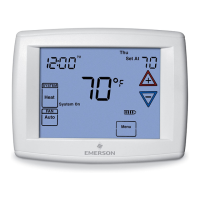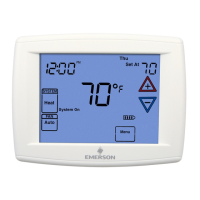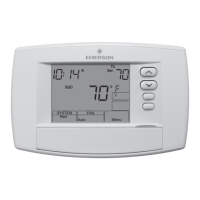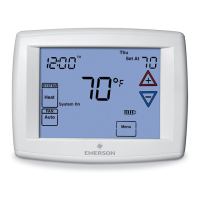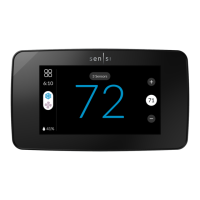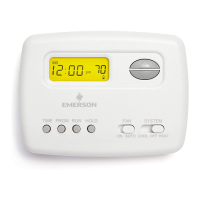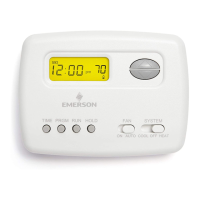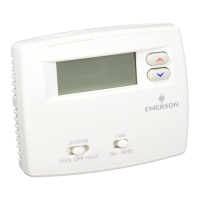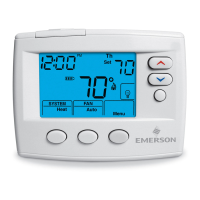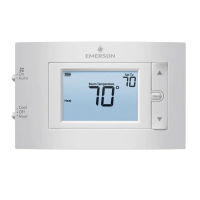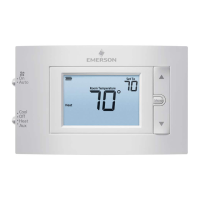Model Programming Choices
1F95-1277
7 Day 5+1+1 Day Non-Programmable
white-rodgers.com
emersonclimate.com
Blue Universal Touchscreen Thermostat with
Automatic Heat/Cool Changeover Option
PART NO. 37- 6753E
Replaces 37-6753D
1517
Single Stage, Multi-Stage, Heat Pump
Installation and Operating Instructions
APPLICATIONS
SPECIFICATIONS
1F95-1277 Touchscreen Thermostat
Save these instructions for future use!
FAILURE TO READ AND FOLLOW ALL INSTRUCTIONS
CAREFULLY BEFORE INSTALLING OR OPERATING THIS
CONTROL COULD CAUSE PERSONAL INJURY AND/OR
PROPERTY DAMAGE.
THERMOSTAT APPLICATION GUIDE
Thermostat
Configuration Options
Thermostat
Applications
Maximum
Stages
Heat/Cool
Single Stage 1
No Heat Pump (SS1)
Gas, Oil, Electric, Heat Only,
Cool Only or Heat/Cool
Systems, 2 or 3 wire Hydronic
Zone (Hot Water or Steam)
Systems, 24 Volt or Millivolt
1+1
Multi Stage 2
No Heat Pump (MS2)
2+2
Heat Pump 1
Single Stage Compressor
Heat Pump (HP1)
Single Stage Compressor
Heat Pump Systems - up to 2
Stages Aux./Emergency Heat
3+1
Heat Pump 2
Two Stage or Two
Compressor Heat Pump
(HP2)
Two Stage or Two Compressor
Heat Pump systems - up to 2
Stages Aux./Emergency Heat
4+2
ATTENTION: MERCURY NOTICE
This product does not contain mercury. However, this
product may replace a product that contains mercury.
Mercury and products containing mercury must not be
discarded in household trash. Do not touch any spilled
mercury. Wearing non-absorbent gloves, clean up any
spilled mercury and place in a sealed container. For proper
disposal of a product containing mercury or a sealed
container of spilled mercury, place it in a suitable shipping
container. Refer to www.thermostat-recycle.org for
location to send the product containing mercury.
Index Page
Installation 2
Wiring Diagrams 3
Thermostat Quick Reference 4
Installer Configuration Menu 5
Operating Your Thermostat 9
Programming 10
Troubleshooting 13
Electrical Rating:
Battery Power .......................... mV to 30 VAC, NEC Class II, 50/60 Hz or DC
Input-Hardwire ......................... 20 to 30 VAC
Terminal Load ............................. 1.5A per terminal, 2.5A maximum all terminals combined
Setpoint Range ............................ 45 to 99°F (7 to 37°C)
Rated Differentials: Fast. Slow
Heat (Single Stage/Multi-Stage) ............ 0.6°F 1.5°F
Cool (Single Stage/Multi-Stage) ............ 1.2°F 1.7°F
Heat Pump ............................ 1.2°F 1.7°F
Emer Heat ............................ 0.6°F 1.7°F
Operating Ambient.......................... 32°F to +105°F (0 to +41°C)
Operating Humidity ......................... 90% non-condensing max.
Shipping Temperature Range ................. -40 to +150°F (-40 to +65°C)
Dimensions Thermostat...................... 4-9/16"H x 5-13/16"W x 1-3/16"D
To prevent electrical shock and/or equipment damage,
disconnect electric power to system at main fuse or
circuit breaker box until installation is complete.
